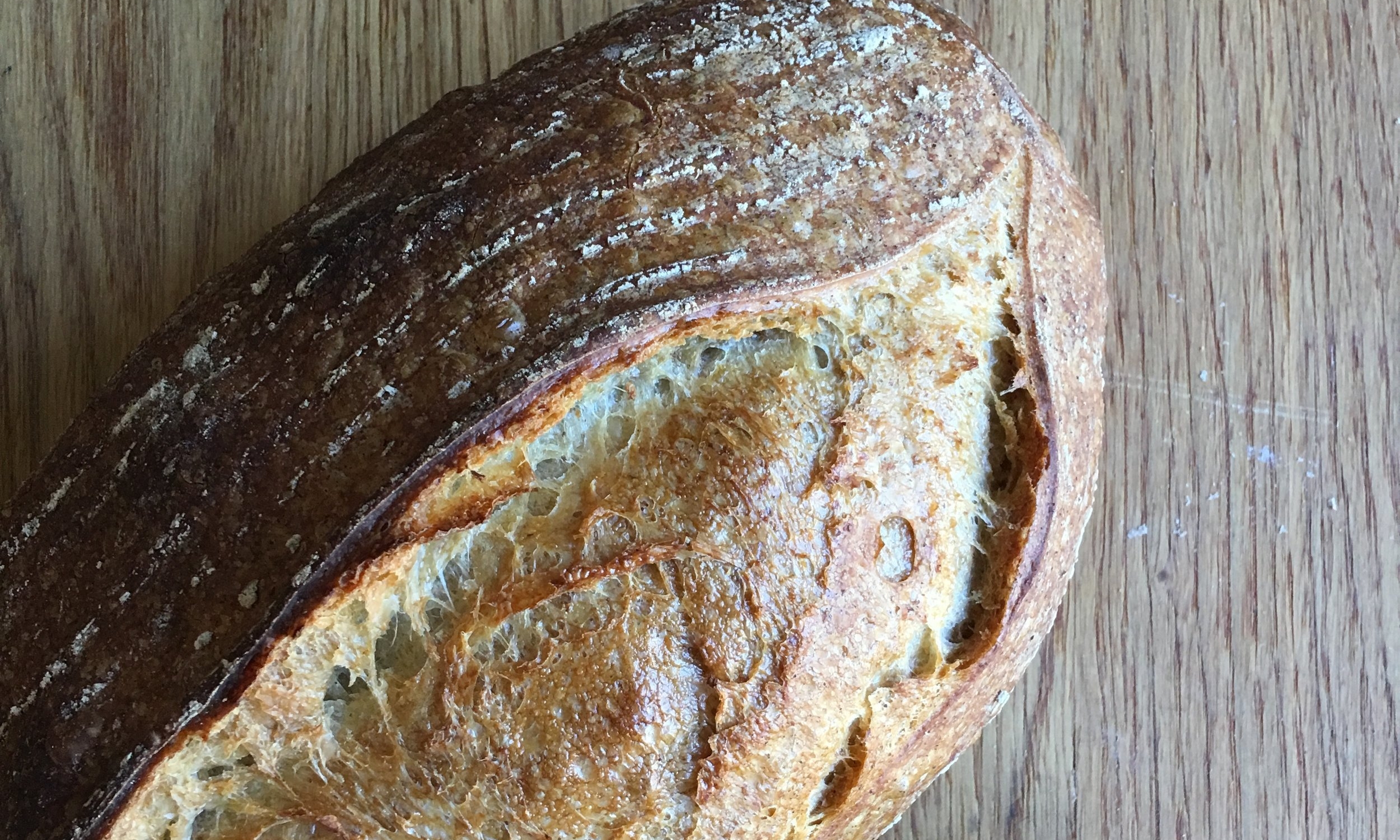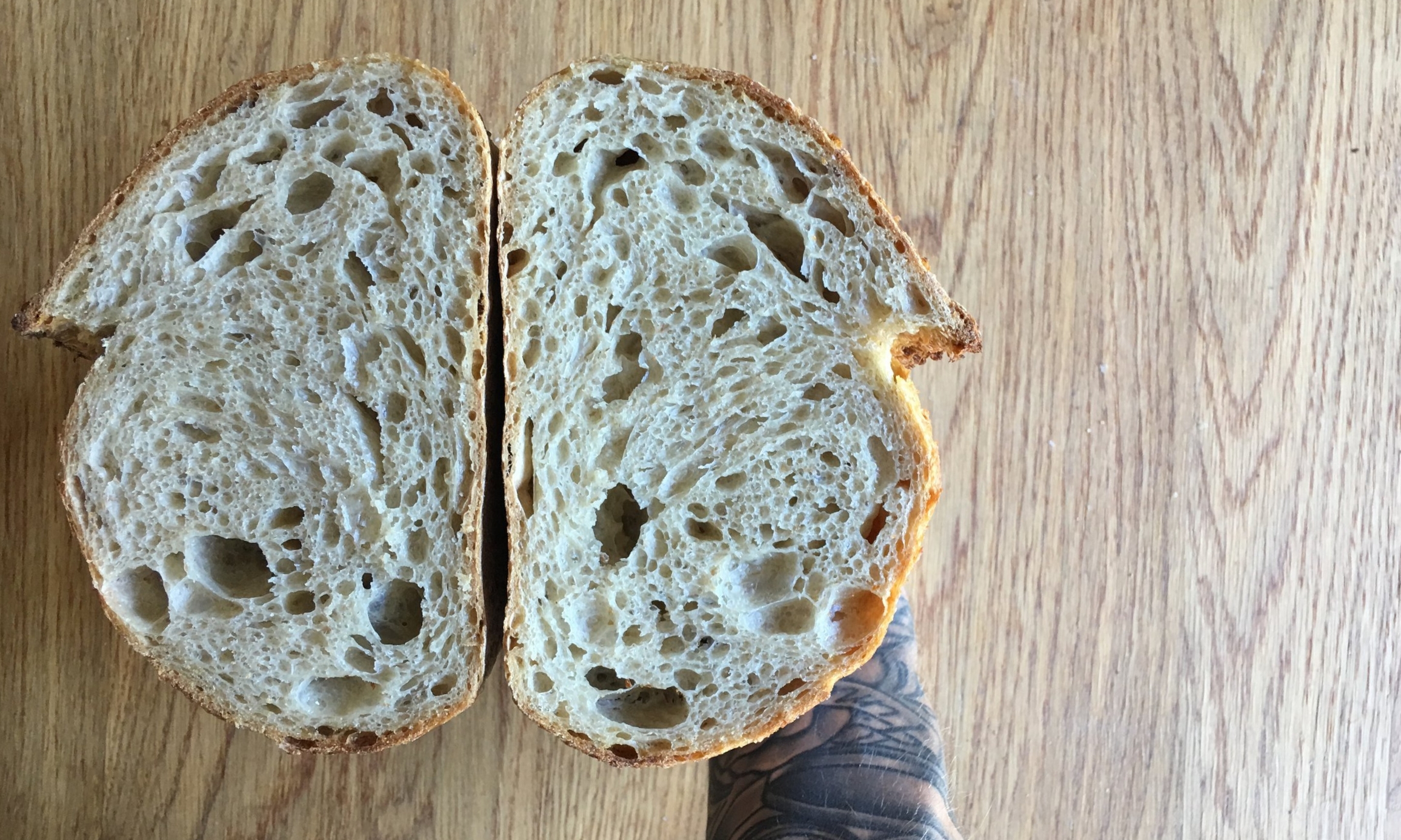There are many, many ways to make a loaf of Sourdough bread. So many methods and techniques, so much conflicting advice online in blogs, books, videos, it's really quite overwhelming and put me off making sourdough for ages. Not to mention that most recipes I saw told me to throw away a portion of my starter on a regular basis!
The truth is that with knowledge of the principle of yeasted bread making, and an understanding of how sourdough bread works, when you actually come to make a loaf you realise how simple it is and really how flexible the process is. In many ways it’s the trickiest bread to make and in many ways the simplest.
Following on from a few sourdough videos I've made recently you guys have been requesting a recipe left, right and centre so here it is. This is the recipe I use week in week out, in the way I do it to fit in with my lifestyle. No waste, no discard. I use a 100% wholemeal rye starter, but you can use whichever you like or already have.
Making sourdough is a real learning experience, expect your first one not to turn out perfect and you’ll learn something every time you try again. Keep it up and remember that sourdough is temperature sensitive.
Have fun!
Sourdough Loaf for Beginners
Notes
This recipe will make one sourdough loaf however, I always make at least two. It’s a long process so you might as well. You’ll get more practice and more to eat and you can always freeze one if you need to.
To make two loaves double the recipe, follow the same method, and divide the dough into two at the pre-shape stage.
Before you begin you’ll need to have made a Rye sourdough starter. However, the photograph below (as lovely as it looks) is a little deceiving, since you won’t need any where near that amount. Don’t expect it to look like the one in the picture…
Difficulty: Tricky
My Kitchen Temperature: 21°C/70°F
Start to finish: 36 hours (Don’t be afraid, actual working time is minimal)
Quick Timing Guide
Day 1
Feed up your starter in the evening
Day 2
Mix your Dough, 30 minute rest
1st Fold (12 folds), 2 hours rest
2nd Fold (6 folds), 2 hours rest
3rd Fold (6 folds), 1 hour rest
Preshape, 1 hour rest
Final shape, into basket, refrigerate
Day 3
Bake
Ingredients
Day 1
Sourdough Starter Scrapings in your Pot
50g Wholemeal Rye Flour
50g Room Temperature Water
Day 2
100g Excited sourdough starter from above (take this from your pot and leave the scrapings for next time)
450g Strong white bread flour
310g Room temperature water
8g Salt
Method
Day 1 - Feeding your starter
The day before you want to make your dough, you’ll need to feed up your start scrapings.
1. Into your starter pot add 50g of room temperature water, and 50g of Wholemeal Rye flour and mix together well. Scrape down the edges to level off the mixture and mark on the side of the pot with a pen or elastic band where the mixture comes up to.
2. Leave this on your kitchen side at room temperature overnight or for 8-12 hours and it will bubble and increase in volume. If it’s been a while since you baked (two weeks or more) your starter might get a little sleepy in there and require a couple of feeds to get it excited again.
3. The following morning your starter should have produced gas and increased in volume. You’re good to go.
Day 2 - Making your dough
1. Take 100g of your starter out of the pot and put in in a large bowl, put your scraping pot in the fridge for next time. Add the water flour and salt and mix it together into a dough with your dough scraper. Mix for a minute or so to make sure everything is combined. Let this mixture rest and soak for 30 minutes.
First Fold
2. Spray the work surface with water, and the top of your dough. Turn the dough out onto the wet surface upside down. Work around the dough pinching a piece with your finger and thumb, stretching it out and folding it back over the dough making a ball. Around 12 folds should be enough. Roll the dough back over, smooth side up, return it to the bowl, spray the top with water, cover with a clean cloth and leave to rest for 2 hours at room temperature.
Second Fold
3. After the dough has rested it should have puffed up slightly already. Spray the table and dough again with water. Turn the dough out and reshape into a ball. 6 stretches and folds should be enough this time, roll the dough over with the smooth side on top and tuck everything underneath with your hands. Return the dough to the bowl for a further 2 hours.
Third Fold
4. After the dough has rested for this second time there should be clear signs of the dough rising, Stretch and fold the dough once more exactly like the last time, and return the dough to the bowl to rest for 1 hour.
Pre-shape
5. This time after resting it’s time to pre-shape the dough. Dust your surface with flour, turn out your dough upside down onto the surface. If you have doubled the recipe to make two loaves, divide it into two at this point with the flat side of your dough scraper. Shape the dough into a ball really quite tight without tearing it. Rest on the side for 1 hour covered with a cloth.
Sourdough Gear
Get everything you need
Final Shape
6. In the final shaping the aim is to create a tight structure without degassing the dough too much. So be delicate with the folds but still creating tension. Dust your work surface with a little flour, slide your dough scraper underneath and turn the dough upside down onto a lightly dusted surface. Let it relax into a circle. Pick up the side edges one by one, stretching out very slightly and folding over the dough, one over the top of the other. Roll the dough from the top edge towards you into a sausage and stick it onto the sticky patch closest to you, pinching the seam to stick in place. When you are done, dust it well with semolina or a wholemeal flour, and dust an oval banneton basket too. Place the dough in the basket upside down (seam side up). If you don’t have a basket, line a colander or bowl with a cloth and dust it well.
Final Rest
7. At this stage rest your dough in the fridge uncovered to prove nice and slowly overnight.
Day 3 - Baking your loaf
1. When you are ready to bake, remove your loaf from the fridge and let it rest on the kitchen side while the oven preheats. It should show clear signs of inflation, don’t expect huge growth but certainly it should have plumped up since you put it in the fridge. Preheat the oven to 230°C fan/456°F/gas mark 8 with a baking stone on the middle shelf and a deep tray on the bottom. Boil the kettle too.
2. Turn out the loaf out onto a floured peel, make a cut in the top with a grignette and slide it onto the baking stone. Pour the hot water from the kettle into the tray to create steam and shut the door.
3. Bake for 15 minutes, then turn down the heat to 190°C fan/374°F/gas mark 5 and bake for a further 20-25 minutes.
4. Allow to cool completely on a wire rack before slicing.






